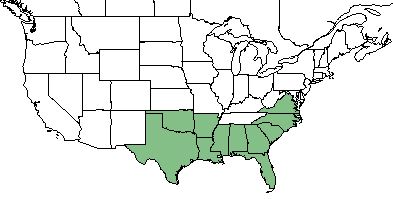Difference between revisions of "Smilax smallii"
| Line 40: | Line 40: | ||
===Use by animals=== <!--Herbivory, granivory, insect hosting, etc.--> | ===Use by animals=== <!--Herbivory, granivory, insect hosting, etc.--> | ||
| − | ''S. smallii'' comprises 5-10% of the diets of large mammals, small mammals, and terrestrial birds.<ref name="Miller & Miller 1999">Miller JH, Miller KV (1999) Forest plants of the southeast and their wildlife uses. Southern Weed Science Society.</ref> | + | ''S. smallii'' comprises 5-10% of the diets of large mammals, small mammals, and terrestrial birds.<ref name="Miller & Miller 1999">Miller JH, Miller KV (1999) Forest plants of the southeast and their wildlife uses. Southern Weed Science Society.</ref> Larger mammals can include deer and cattle.<ref name="Thill 1984">Thill RE (1984) Deer and cattle diets on Louisiana pine-hardwood sites. The Journal of Wildlife Management 48(3):788-798.</ref> |
<!--==Diseases and parasites==--> | <!--==Diseases and parasites==--> | ||
Revision as of 11:21, 22 January 2018
| Smilax smallii | |
|---|---|

| |
| Photo by John Gwaltney hosted at Southeastern Flora.com | |
| Scientific classification | |
| Kingdom: | Plantae |
| Division: | Magnoliophyta - Flowering plants |
| Class: | Liliopsida - Moncots |
| Order: | Liliales |
| Family: | Smilacaceae |
| Genus: | Smilax |
| Species: | S. smalliis |
| Binomial name | |
| Smilax smallii Morong | |

| |
| Natural range of Smilax smallii from USDA NRCS [1]. | |
Common Name(s): Jackson-briar;[1] lanceleaf greenbrier;[2] southern smilax; jacksonvine[3]
Contents
Taxonomic Notes
Synonym(s): S. maritima;[1] S. domingensis; S. lanceolata[2]
Description
Smilax smallii is a monoecious perennial that grows as a shrub or vine.[2] Leaves are small, light-green, shiny, and evergreen. Flowers are small, yellowish, and in clusters. Berries will remain a dull, brick red color for long periods of time before turning a dark reddish brown at maturity. Stems typically lack spines and occur at right angles to the main stem. This plant can reach lengths of 6-12 ft (1.83-3.66 m).[3]
Distribution
This species primarily occurs on the coastal plain from Virginia, south to central peninsular Florida, westward to Texas.[1][2] It can also be found in Puerto Rico.[2]
Ecology
Habitat
S. smallii is found in bottomland forests.[1] It prefers moist alluvial acidic soils.[3]
Phenology
Flowering occurs from May through July[1][4] and fruits from April to June of the following year.[1] A study in Florida, reported flowering in June and fruiting from February through July.[5]
Use by animals
S. smallii comprises 5-10% of the diets of large mammals, small mammals, and terrestrial birds.[6] Larger mammals can include deer and cattle.[7]
Conservation and Management
Cultivation and restoration
Propagation can occur via root divisions, seeds, semi-hardwood cuttings, and softwood cuttings.[3]
Photo Gallery
References and notes
- ↑ 1.0 1.1 1.2 1.3 1.4 1.5 Weakley AS (2015) Flora of the Southern and Mid-Atlantic States. Chapel Hill, NC: University of North Carolina Herbarium.
- ↑ 2.0 2.1 2.2 2.3 2.4 USDA NRCS (2016) The PLANTS Database (http://plants.usda.gov, 22 January 2018). National Plant Data Team, Greensboro, NC 27401-4901 USA.
- ↑ 3.0 3.1 3.2 3.3 Plant database: Smilax smallii. (22 January 2018) Lady Bird Johnson Wildflower Center. URL: https://www.wildflower.org/plants/result.php?id_plant=SMSM
- ↑ Nelson G (22 January 2018) PanFlora. Retrieved from gilnelson.com/PanFlora/
- ↑ Skeate ST (1987) Interactions between birds and fruits in a northern Florida hammock community. Ecology 68(2):297-309.
- ↑ Miller JH, Miller KV (1999) Forest plants of the southeast and their wildlife uses. Southern Weed Science Society.
- ↑ Thill RE (1984) Deer and cattle diets on Louisiana pine-hardwood sites. The Journal of Wildlife Management 48(3):788-798.